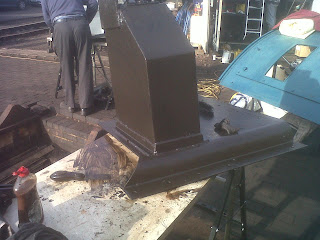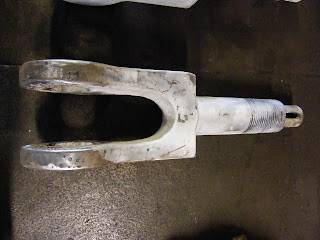The boiler for 7820 came out of Barry with the locomotive. In order to get it steaming again in essance all that was required was replacement of the tubes, some stay and rivet replacement and off she went. Having completed a ten year ticket and never having had a major overhaul since BR days certain areas of the boiler had reached the end of their life. The photos below, whilst looking like a horror wall, show the issues which arrise in an old boiler and need adressing periodically. Whilst these more major repairs do not occur every ten years like tubes, stay and rivets they are longer term repairs which have to be addressed.
The main area of repairs on the copper box has concentrated on the laps. After years of tooling and caulking the laps get thin and eventually they crack at the weak points around the rivet holes. Here you can see how two holes in the door plate have cracked out to the edge of the plate.

At the lower edge of the door plate rivets connect the inner door plate to the foundation ring and the outer plate. These rivet heads waste away over time and are replaced at overhauls if the heads have reduced beyond acceptable limits. Each time a rivet is replaced more strain is placed on the platework as the rivet cools and contracts. In addition each time the loco boiler goes through a heat up and cool down cycle or a fireman misses a bit of the grate and the fire goes thin resulting in cold air being drawn in to the fire box more stress is placed on the platework. All this stress shows up in corners and around fixing points such as rivets, stays and tubes. Above the result of all that stress has manifested itself as a crack radiating off from a foundation rivet hole.

The above shows a very wasted and thinned section of lap. The only solution here is to cut out the offending section and then weld in a new section restoring the material back to its proper profile. Quite a lengthy and costly process when you take into account the cost of copper, the intricacies of welding copper and the labour involved in shaping the plate and redrilling the holes to line up with the sister plate.
As mentioned above with all of the heating a cooling cycles a boiler goes through it moves, each time it moves parts flex, repeated flexing of a component causes fatigue and eventually stress cracking. The above photo shows the cracks from the stresses occuring in the tube plate where one element is restrained by the tubes and the other is riveted to the side plates.
Moving onto the steel firebox, this has not escaped from repeated stressing. Above a crack in the throat plate can be seen after polishing of the steel to make it show up. Again this has occured at a corner where stresses are concentrated. Taking into account wastage and grooving found in the remainder of the throat plate, the decision was taken to manufacture a new throat plate. More on that later.
Lastly; probably the worst bit of copper lap I have ever seen. What was originally a thick piece of copper has been reduced to fresh air leaving little material around the rivet heads. Again time for a new section of lap.



























